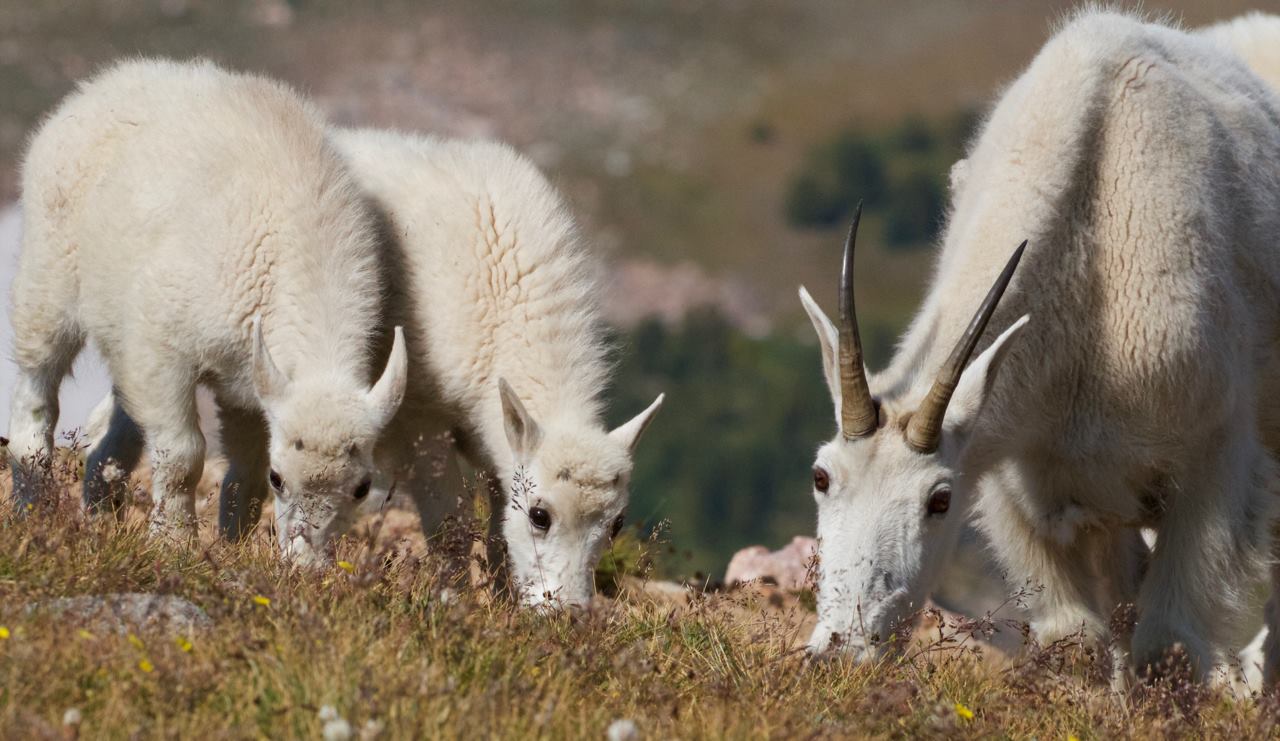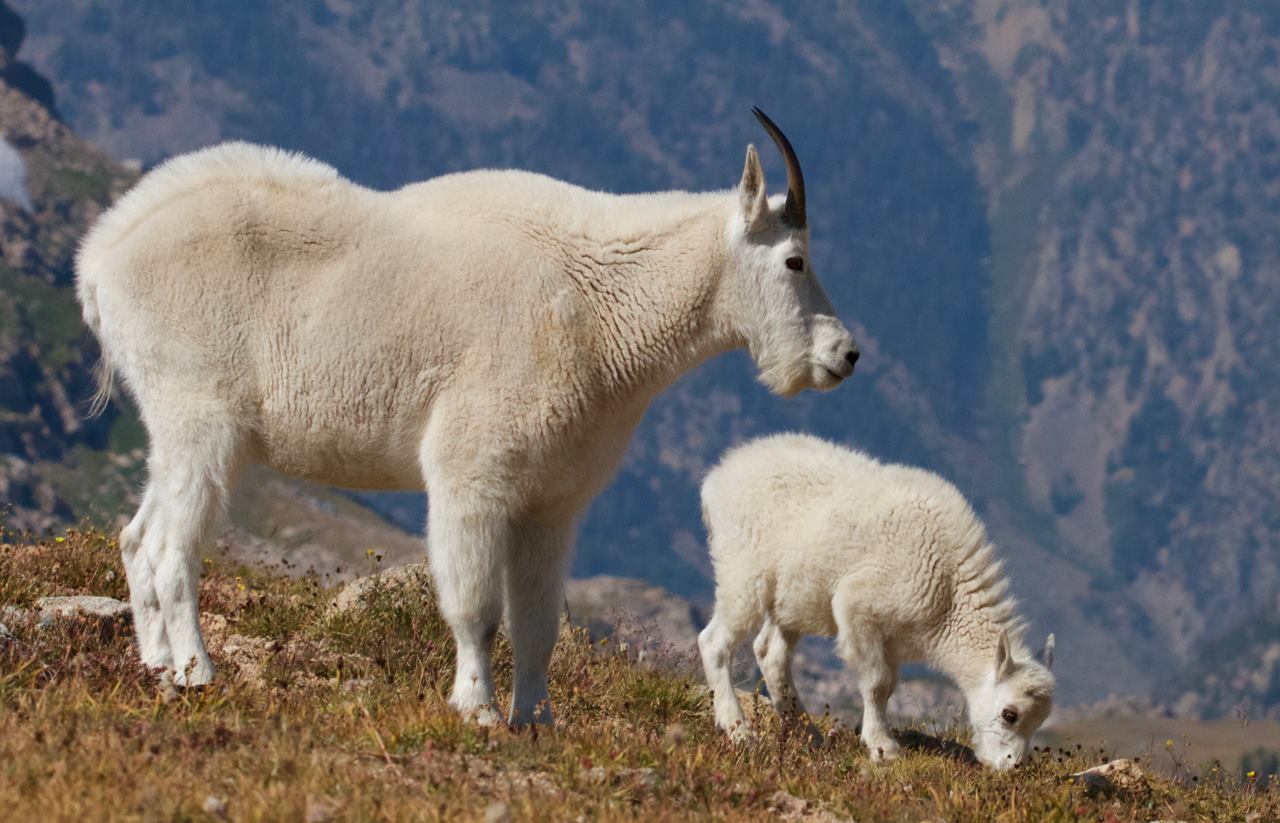“Mountain goats. Beartooth Plateau, Wyoming," writes Jay Anderson in sharing these three photos with us. "Part of the greater Yellowstone ecosystem.” These amazingly sure-footed climbers and leapers (able to soar up to 12 feet in a single bound) are not actually goats; they're part of a family that includes gazelles and antelopes. They're able to maneuver on steep slopes in part because their cloven hooves have inner gripping pads and sharp, curved, anti-slipping dewclaws and can be spread apart for traction. The age of a mountain goat can be determined by counting the growth rings on their horns, which they don't shed. Many thanks to Jay for his photos. Have you ever seen or photographed a mountain goat?
The strong, whipping winds at the Camas National WIldlife Refuge in Idaho made flying hard work for the migrating waterfowl—and holding a camera steady impossible for a photographer.
Blowing Into Idaho
As part of my freelance assignment, I'm writing blog entries that will run on the Via magazine website next year around the time the Pacific Flyway birding article comes out . Therefore I can't reveal here in the Notebook blog all the best details of the three-week trip Pamelia and I are on. However, there's still plenty to show and tell.
This frisky young elk raced back and forth along the Madison River in Yellowstone.
Yesterday we headed back into Yellowstone despite a snow and rain storm. The touch of winter only made the park more spectacular. We saw many elk, antelope, bison and, yes, even birds to add to our story list. In a cosmic twist, even as the Buffalo Bills were playing the Baltimore Ravens in an NFL game, ravens and buffalo were playing right in front of our car. A raven sat on the hood of the Nissan Altima staring in at us as a herd of bison passed right in front of us.
Several times we found ourselves in the middle of a herd of bison. One clueless woman got out of her car and stood a few feet in front of a bison to take its photo. She was lucky; the animal didn't attack her, as sometimes happens with park visitors.
Despite the cold, blowing rain and snow, we stopped to watch Old Faithful. I was both startled and not surprised (given that we're talking about American tourists) that half the people watching that amazing geyser erupt tturned and walked away (!!!) only a minute into the roughly three-minute spectacle. Hey, they'd gotten their snapshot—why wait around? It was like spectators leaving in the middle of a no-hitter just to beat the traffic home.
Because Yellowstone sits atop a supervolcano, it never fails to put on an eerie, awesome show of thermal pools and mud pots.
These pronghorn antelope greeted us as soon as we entered Yellowstone.
This elk let out a mighty, high-pitched, valley-filling cry to its companions, calling them over before the whole group crossed the road,
We ended up spending the night in Idaho Falls because the weather (40 mph winds, deluge of rain, dark of night) made continuing farther south unsafe. The weather cam for the local TV station is still shaking this morning from the winds, but we'll leave in a few minutes for Utah and the Bear River Migratory Bird Refuge, which sits on the northern tip of the Great Salt Lake. We'll likely see more snow in the day ahead, but maybe it will again make everything more beautiful.
The world gets a shakeup in Roland Emmerich's now-rentable catastro-flick.
Maine Movie Night: Earth Disaster!
The President's chief of staff looked alarmed as he studied the computer-projection map. “You're telling me the North Pole is now in Wisconsin?" he asked.
“Actually, that's the South Pole,” corrected the scientist standing beside him.
Those memorable lines—uttered, of course, in an underground bunker—scarcely hint at the mad, mad world created by a blast of solar neutrinos that disastrously overheat the Earth's core in the movie 2012. Pamelia and I saw that mind-bending, science-defying box-office blockbuster (worldwide gross: nearly $800 million) on pay-per-view the other night. Watching the planet shake, quake, volcanically erupt, launch thousand-foot tidal waves and rain Hummer-sized fireballs onto unsuspecting citizens brought back memories of the evening news, which had immediately preceded it.
This movie ought to be shown in Earth-science class in high schools. First, because no kid would tune out—the action and special effects are nonstop—but, more important, because it raises good, brain-teasing questions about physics, chemistry, astronomy, geology, oceanography, seismology and—my field of interest—popcornology.
For example, on a really, really bad day, could the South Pole actually end up in Wisconsin?
The North and South poles have in fact swapped positions (or reversed polarities, so that a compass would point to the South Pole) tens of thousands of times over the last few billion years. These reversals can be "read" by scientists based on the direction in which certain volcanic rock has been magnetized. The orientation can even help them determine the age of the rock. However, it is safe to say that polar bears and penguins have never, and will never, set foot on the famous "frozen tundra" of Green Bay. And despite the allure of Schlitz beer and between-innings sausage races at Brewers games, there is no evidence that either pole has ever stopped in Milwaukee.
So what about sea level rising to the top of the Himalayas, as it does in the movie?
Let's see, that would be a rise of about 29,000 feet. To allay the fears of doomsayers (and disappoint all those sherpas who hoped to be surfers), disasterologists already did the math: If all the ice melted at both poles and in every glacier and, I guess, in every ice machine at every chain motel in every two-bit town around the globe, sea level would rise only between 200 and 250 feet. Given that oceans have, in past millennia, covered much, if not most, of what is now the United States (at The Naturalist's Notebook we have a slab of sea fossils from inland Maine, and similar evidence has been found in places like Kansas and Ohio), a 200-foot rise seems entirely plausible. But it doesn't make for a 2012-scale movie spectacle or splashy advertising copy ("A film that's ...very plausible!"—Chicago Tribune).
All right then: Yellowstone National Park. Is it really sitting atop a supervolcano?
That one is true. It explains the geysers, the hot springs and the other features that are also found all over—cue the ominous music—Iceland. The Yellowstone volcanic caldera (a cauldron of hot stuff) covers 1,316 square miles. It has been estimated that a major eruption at Yellowstone could bury half the United States under three feet of ash, darken the sky and plunge the world into what the BBC has described as "the equivalent of a nuclear winter." Enjoy your vacation!
What's the deal with the year 2012 and the Mayan prophecies of the world ending on December 21 of that year?
They didn't prophesy that. But if we started seriously analyzing all the things that certain cultures and religions did or did not predict—and how ludicrous most of those predictions are in the first place—we'd lose a lot of good movie plot lines. And keep in mind that the Mayans couldn't even predict their own collapse as a civilization.
One last question: What exactly are neutrinos, anyway?
They're tiny particles produced by the Sun, and more than 50 trillion of them travel through your body every second. They do no harm to you. They do not cause the Earth's core to overheat. Still, as a popcornologist, I wondered whether 2012 director Roland Emmerich might have made even better use of the roasting power of his Hollywoodized solar particles. Maybe this would have been too Spielberg, but why not a foretelling scene early on in which the awkward teenage boy working the concessions stand at a movie theater suddenly sees his popcorn popping itself? Here come the neutrinos! We're all cooked!
By the way, for all his cataclysmic movies (he also made the alien-invasion film Independence Day and the global-warming-themed The Day After Tomorrow), Emmerich professes strong support for environmental causes and says he'd really like to save the planet. Though he did say jokingly in an online Q-and-A that because Maine voters (narrowly) repealed the state's gay-marriage law last year (Emmerich is openly gay), he might have to wipe the state out with a tidal wave in a future film.



